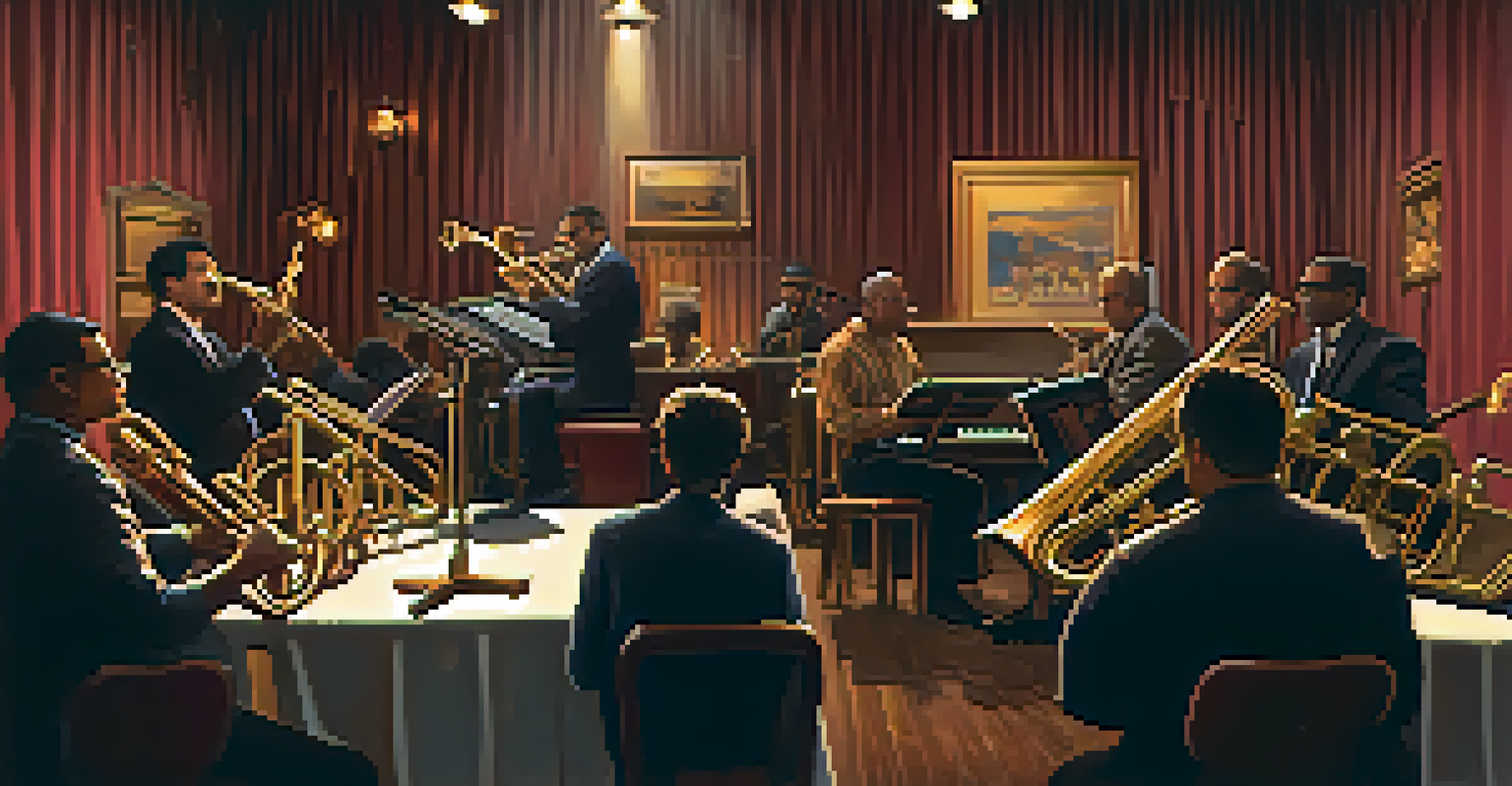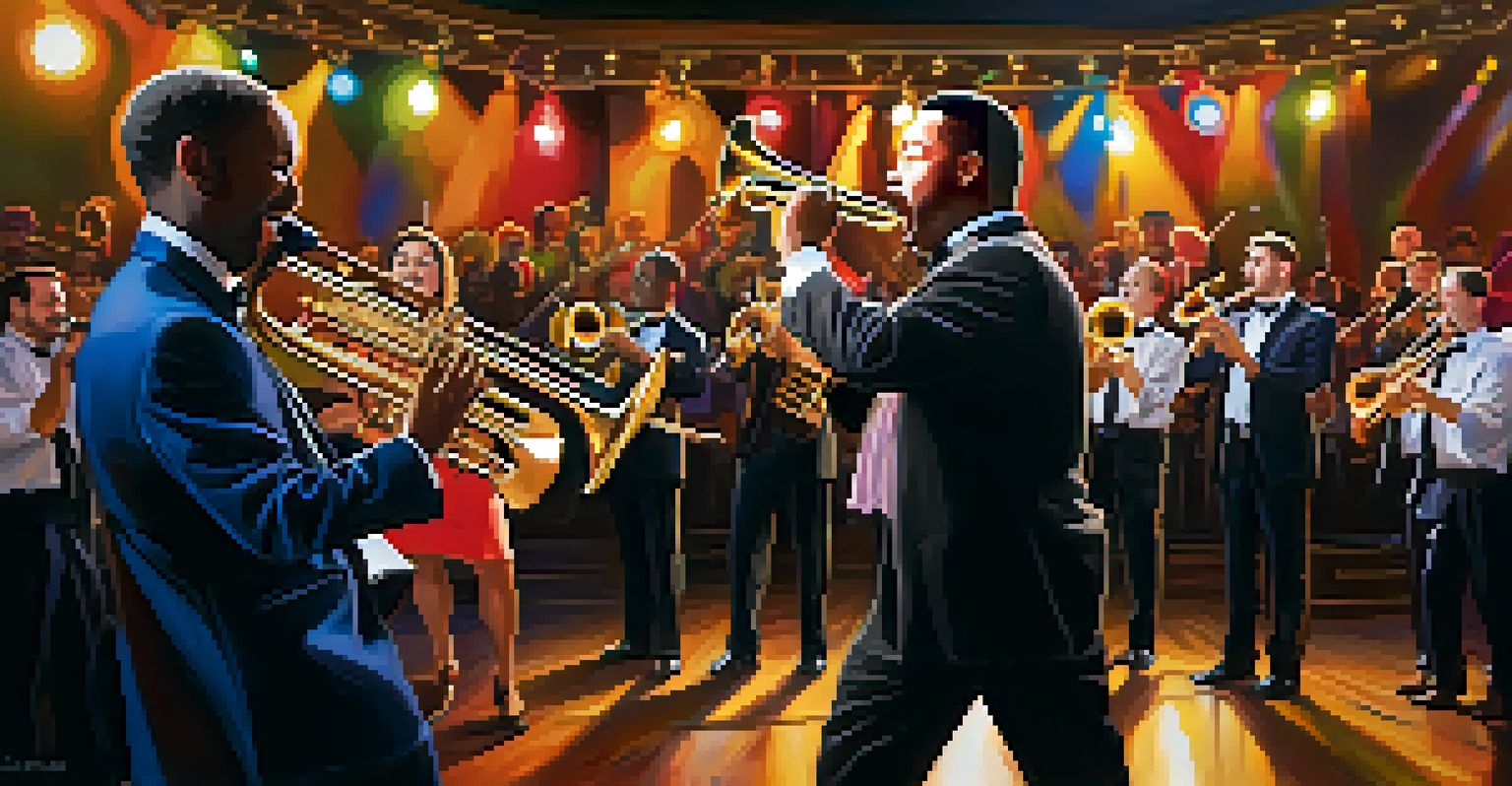Jazzing Up the Ukulele: Integrating with Brass Instruments

Understanding the Unique Voices of Ukulele and Brass
The ukulele and brass instruments each have their own distinct sound. The ukulele, with its bright, cheerful tones, creates a light-hearted melody, while brass instruments like trumpets and trombones bring depth and richness to the mix. When combined, these instruments can create a dynamic musical conversation that captivates listeners.
Music can change the world because it can change people.
Imagine a sunny beach day where the ukulele strums a lively tune, and suddenly, a trumpet joins in with smooth, melodic lines. This fusion not only enhances the overall sound but also provides a platform for creativity and improvisation, key elements in jazz music. The contrasting timbres can complement each other beautifully, making it a unique experience.
In jazz, the blend of instruments creates layers of complexity, inviting musicians to explore harmonies and rhythms that elevate their performances. Understanding how these two worlds can connect lays the foundation for creating captivating music that resonates with audiences.
Choosing the Right Brass Instruments for Ukulele Collaborations
Not all brass instruments will suit your ukulele style, so choosing the right ones is essential. Instruments like the trumpet or saxophone can harmonize well with the ukulele’s cheerful sound, while trombones can add a richer, deeper tone. The goal is to find instruments that enhance your melody rather than overpower it.

Consider the mood you want to convey with your music. If you’re aiming for a lively, upbeat performance, a bright trumpet can lift the spirit. On the other hand, if you’re looking to create a more mellow, jazzy vibe, a soft saxophone might be the perfect companion for your ukulele.
Distinct Sounds of Ukulele and Brass
The ukulele's bright tones and brass instruments' richness create a captivating musical conversation.
Experimenting with different brass instruments can help you discover unique combinations that resonate with your style. The beauty of jazz lies in its improvisational nature, so don’t hesitate to try new pairings and see what feels right for your music.
Exploring Jazz Chords and Progressions for Ukulele
Jazz is known for its complex chord structures, and the ukulele can easily adapt to these. Start by learning some essential jazz chords, such as seventh chords, which add depth to your playing. For example, a C7 chord can add a touch of tension and anticipation to your melodies, inviting brass instruments to respond with flair.
Jazz is the only music in which the same note can be played night after night but differently each time.
Incorporating these chords into your ukulele playing opens up a world of harmonic possibilities. As you progress, try experimenting with chord progressions that are commonly used in jazz, like the ii-V-I progression. This can create a familiar yet exciting framework for your brass partners to improvise and interact.
The interplay between the ukulele’s chords and brass melodies can create beautiful musical landscapes. By mastering jazz chords, you empower both yourself and your brass collaborators to explore new musical territories.
Creating Melodic Dialogue Between Ukulele and Brass
One of the most exciting aspects of combining the ukulele with brass instruments is the opportunity for melodic dialogue. Think of it as a conversation where the ukulele sets the tone, and the brass instruments respond with their unique voices. This back-and-forth creates a rich tapestry of sound that keeps listeners engaged.
To achieve this, start by establishing a main melody on your ukulele. Once you have a strong foundation, invite the brass instruments to embellish or respond to that melody. For example, after playing a line on the ukulele, leave space for a trumpet to add a riff or a saxophone to take a solo.
Choosing Brass for Ukulele Harmony
Selecting the right brass instruments can enhance the ukulele's melody without overpowering it.
This call-and-response style not only enhances musical interaction but also encourages improvisation. As you and your brass players become more comfortable with each other, these conversations can lead to spontaneous moments of magic on stage.
Improvisation Techniques for Ukulele and Brass Fusion
Improvisation is at the heart of jazz, and it’s where the ukulele and brass can truly shine together. As a ukulele player, you can develop your improvisational skills by practicing scales and arpeggios that will complement the brass melodies. Familiarity with your instrument will give you the confidence to experiment and take risks during performances.
Listening to jazz greats can also inspire your improvisation. Pay attention to how they navigate their solos, and observe the interplay between instruments. This can provide valuable insights into creating your own unique style while collaborating with brass players.
Don't forget that improvisation is about expressing yourself. Allow your personality to shine through your playing, and encourage your brass counterparts to do the same. The result will be a vibrant, energetic performance that leaves a lasting impression.
Arranging Music for Ukulele and Brass Ensembles
Once you've explored the basics of blending ukulele and brass, it’s time to delve into arranging music. This involves deciding which parts each instrument will play and how they’ll interact throughout the piece. A well-thought-out arrangement can significantly enhance the overall sound and cohesion of your ensemble.
Start by determining the key sections of your music, such as the intro, verses, and solos. Assign specific roles to each instrument, ensuring that the ukulele provides a strong foundation while brass instruments add color and texture. For example, you might have the ukulele play the main melody while the trumpet harmonizes, creating a richer sound.
Improvisation: Key to Dynamic Duets
Improvisation allows for expressive performances, enabling ukulele and brass players to create spontaneous musical moments.
Don't shy away from experimenting with dynamics and rhythms in your arrangements. Varying the volume and intensity between the ukulele and brass can create dramatic moments that capture the audience's attention and keep them engaged.
Performing Live: Tips for Ukulele and Brass Collaborations
When it comes to performing live, the synergy between ukulele and brass is key to captivating your audience. Start by rehearsing together to develop a strong sense of timing and dynamics. Practice makes perfect, and the more familiar you are with each other's playing styles, the more seamless your performance will be.
Consider the stage presence as well. Engaging with your fellow musicians and the audience can create an electric atmosphere. Encourage interaction between performers and with the crowd, as this connection can elevate the entire experience.

Lastly, be open to spontaneity during live performances. Jazz thrives on improvisation, so if the moment strikes, allow room for unexpected solos or playful exchanges between the ukulele and brass. This not only showcases your musicality but also creates memorable moments for your audience.